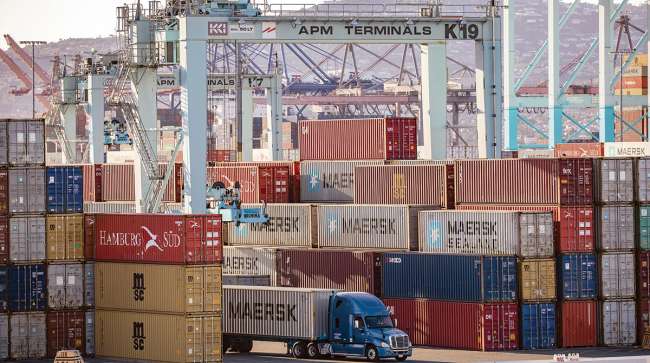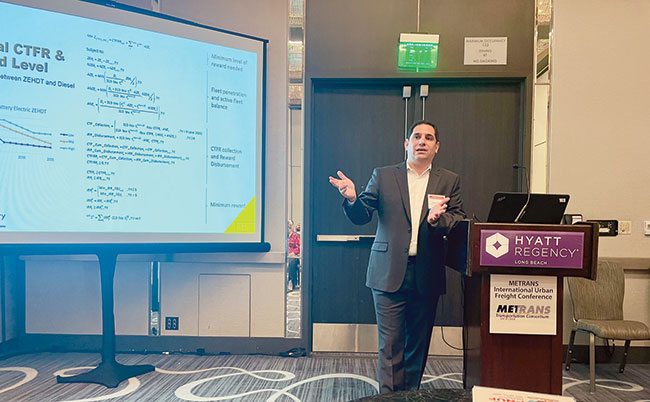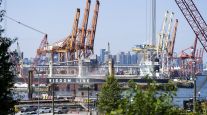Contributing Writer
Proposal Seeks Increase in Port Diesel Fee

[Stay on top of transportation news: Get TTNews in your inbox.]
LONG BEACH, Calif. — San Pedro Bay ports charge $10 per container for transport that isn’t by a zero-emission truck, but an environmental group wants to combine a higher fee with incentives to accelerate adoption of cleaner trucks.
Miguel Jaller, co-director of the Sustainable Freight Research Program at the University of California-Davis Institute of Transportation Studies, said a higher fee could help fund the transition, and believes the system as configured fails to reward clean transport adequately.
“A system like this would internally support the transition without needing external money,” Jaller said during a presentation at the Metrans International Urban Freight Conference held May 25-27. Metrans, a joint partnership of the University of Southern California and California State University-Long Beach, studies how freight movement affects urban areas.

Jaller said a higher fee could help fund the transition, and believes the system as configured fails to reward clean transport adequately. (Jerry Hirsch for Transport Topics)
Jaller, and Emil Youssefzadeh, founder and chairman of Long Beach-based WattEV Inc., an electric trucking startup, say the ports alone — with a population of about 20,000 diesel trucks — could claim all the funding California has set aside to subsidize the transition to zero-emission tractors.
Electric Class 8 trucks cost around $350,000, about $225,000 more than a diesel counterpart. Writing down the cost of the estimated 20,000 trucks registered to operate at the ports to parity with diesel tractors would suck up more than $4 billion, Jaller said. And that still doesn’t account for the funds the state and the freight industry will need for other California ports and trucking, he said.
According to port officials, the $10 fee, launched this year after pandemic-related delays, will raise about $90 million annually between the Port of Los Angeles and Port of Long Beach.
Instead, Jaller proposes that the ports charge between $22 and $56 per loaded TEU, or 20-foot equivalent container. This would support a reward of about $90 per TEU transported by a zero-emission truck. The proposal suggests a gradual reward decrease to about $5 to $23 per TEU in 2035, California’s target for phasing out diesel trucks.
The charge and the reward don’t have to be parallel to work — far more money would be collected at the outset because the majority of freight still would be moved by diesel trucks. Less incentive money would be needed in later years as more trucks would be zero-emission. Moreover, the value of the rewards dips as revenue from the charges declines.
“As the time goes by, the price differential between the technologies would be lower, thus less incentives would be needed,” Jaller told Transport Topics.
Jaller and Youssefzadeh estimate such a fee and reward system would displace 6,000 diesel trucks by 2030 and 17,000 to 18,000 by 2035, reducing more than 10.3 million metric tons of CO2 emissions.
Even if passed through to consumers, the fees are just “cents on the dollar,” Jaller said. The typical shipping container passing through the port complex has a goods value of about $30,000, according to port officials.
Experts said how the ports handle this transition has broad implications for motor carriers, shippers and consumers. The complex ranks ninth globally among ports and accounts for about a third of the goods imported to the U.S., according to the Port of Los Angeles.
The ports know more money is needed to subsidize a transition, but they don’t see the Clean Truck Fund rate — the formal name of the fee — as the sole solution.
“The ports never envisioned that the CTF rate would be the only source of funding needed to pay for the truck transition. Additional support from state and federal grants, as well as from private industry, will be critical to meet our goals,” said Heather Tomley, Port of Long Beach’s managing director of planning and environmental affairs.

Cannon
The ports are being cautious with their approach, said Chris Cannon, director of environmental management for the Port of Los Angeles.
“One of the big concerns raised by the boards of harbor commissioners was that the fee would be passed on to the drivers. While it is charged to the cargo owners, there is no way for us to either see or be involved with their contractual relationship with the truckers who pick up the cargo,” Cannon said.
Setting a low starting fee allows the port to push the transition with less risk to drivers. As the ports analyze who actually pays the fee, adjustments can be made, he said.
The ports also need an approach that doesn’t send business to other U.S. facilities that aren’t pushing the same transition. High fees risk that, Cannon said.
“No one else is doing what we are doing. We are at the leading edge of the technology,” he said.
Want more news? Listen to today's daily briefing above or go here for more info
Regardless of the plan, there is some concern that the supply of zero-emission trucks available to drayage carriers will lag in the near term.
When the California Air Resources Board passed the 2020 Advanced Clean Trucks regulation, it required manufacturers to have at least 40% of their Class 7 and 8 drayage tractor sales be zero-emission vehicles by 2032, Tomley said.
“In the near term, given supply chain disruptions and a rapidly evolving technology landscape,” she said, “supply may not be sufficient to meet early demand.”
Funding remains a problem for fleets transitioning to zero-emission trucks, regardless of the current plans and proposals, said Joe Rajkovacz, director of governmental affairs and communications for the Western States Trucking Association.
He said higher fees will only chase shipping companies to use other ports.
The looming requirement that all new trucks entering port drayage ZEV’s amounts to “a grand experiment in whether government forward pushing mandates really can work and change a market. Many of us think it will be an epic failure,” Rajkovacz said. “We believe ZEV’s are the future but don’t see a meaningful bridge being built to get us there.”




